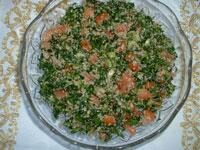Teen Musicians Learn Arabic Music
Was it modern jazz? Or the soundtrack to The Golden Voyage of Sinbad?
The undulating melody issuing – however haltingly – yesterday afternoon from the 15 teens in the Kimmel Center Youth Jazz Ensemble was unmistakable. Even familiar. It was the snake charmers’ melody familiar from old action movies.
Snake charmers? Sinbad? And a jazz band?
The scene at the Kimmel Center’s cramped Education Center on South Broad Street began to make sense when the ensemble’s director, Marc Johnson, handed the baton to the guest of honor, Simon Shaheen.
The internationally acclaimed Palestinian American musician and composer had been invited to lead a two-day series of master classes yesterday and today with three local ensembles as part of an Arabic music program cosponsored by Arabic arts education organization Al-Bustan Seeds of Culture. (Al-Bustan means “the garden” in Arabic.)
The Kimmel ensemble featured students in grades 6 through 10 from around the Delaware Valley. Shaheen focused on “Breeze in Bisaan,” an instrumental piece that engages Western audiences with its playful use of the undulating snake charmers’ melody, which is properly known as the hijaz mode.
“The rhythm is so different” to Western music, said bassist Evan Thomas, 14, of Lansdale, an eighth grader from Pennridge South Middle School. “I love it because it really takes you out of the box and challenges you.”
Christine Emery, 15, a 10th grader at Lower Merion High School, has played trumpet with the Kimmel ensemble for a year.
“I’m excited to learn how to play [this music],” she said. “My mother was born and raised in Iran, so I grew up listening to Middle Eastern music, but I’ve never been able to play it.”
Emery’s mother, Guissou Dabiri, who waited as the teens tuned their instruments, said she was eager to see “how the students will appreciate the music.”
Violin in hand, Shaheen strained to demonstrate one of the key musical differences between Western and Arabic music, the quarter tone. His directions were tailored to his audience, very technical and demanding.
“One of the reasons the melody is so rich in Arabic music is because of this quality called microtonality,” Shaheen, 54, explained in an interview.
“Look at the white and black keys on a piano. The distance between them is a halftone,” he said. “Now, imagine there’s another key between the white and black keys, maybe a red one. That helps you create quarter tones, which can be hard for Westerners to hear, unless they’ve been accustomed to it. In Arabic music we don’t really have harmony because of microtonality and the melodic richness we can produce.”
Shaheen, a Melkite Catholic who grew up in the Israeli Galilean village of Tarshiha, close to the Lebanese border, was trained both in traditional Arabic music and classical Western music.
He achieved international fame in 2001 with the release of Blue Flame, an album that fused jazz and Arabic music.
Hanna Khoury, director of Al-Bustan’s Arab Music Ensemble, was one of the program’s organizers and a fan.
“He’s the first person to bring classical Arabic music from the nightclub scene into concert halls and the academy,” Khoury said.
Khoury, 29, who earned a master’s degree in music from Temple in 2008, also was born in Tarshiha, and is a distant cousin to Shaheen.
“It’s funny, this tiny village of 5,000 has produced some of the region’s best-known musicians,” said Khoury, whose younger brother, Maron Khoury, was recently hired as second flutist by the New York Metropolitan Opera. “I tell people I have about 40 cousins. They are all musicians.”
Temple music major Jerrell Jackson, who plays bass with Khoury’s Al-Bustan’s Arab Ensemble, said he finds Arabic music “freer, looser than [Western] classical music.”
“In a symphonic piece, there are numerous different things the listener can focus on, since each instrument has its own, limited role,” he said. “In Arabic music there is a single thing happening at once – there’s a single melodic line which each instrument interprets and articulates around. Like multiple voices all moving in the same direction.”
Shaheen did two workshops yesterday: After he finished with the Kimmel ensemble, he was scheduled to work with Al-Bustan’s year-old Arab Music Ensemble. Today, the New Yorker is expected to lead a seminar with the Girard Academic Music Program School Jazz Band at Girard’s campus in South Philly. He will return to Philadelphia for a concert on April 25 at University of Pennsylvania’s Irvine Auditorium, featuring select members from the three ensembles he’s teaching.
Khoury, who is music director of the Chicago-based Arabesque Music Ensemble, and has recorded with pop singers including Beyoncé and Shakira, said Al-Bustan’s program can help two important causes.
“I hope it gives more people a taste of how rich our culture can be and how different from the ugliness we see on TV,” he said, referring to the Israeli-Palestinian conflict and the war in Iraq.
“Sadly, our music is being lost – most young Arabic musicians who have the skills to play Arabic music choose to play Western music instead.”
Tirdad Derakhshani
Philli.com


